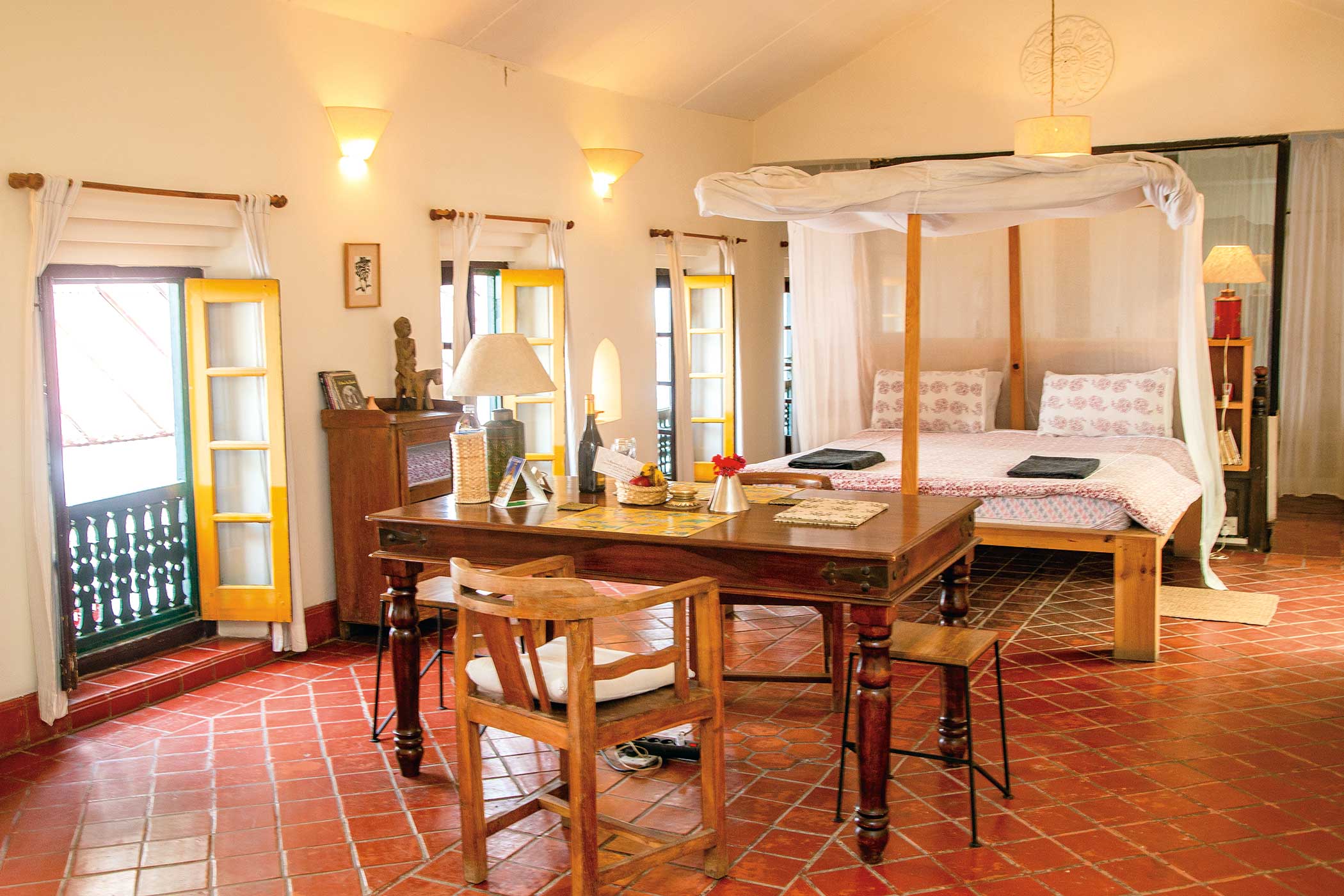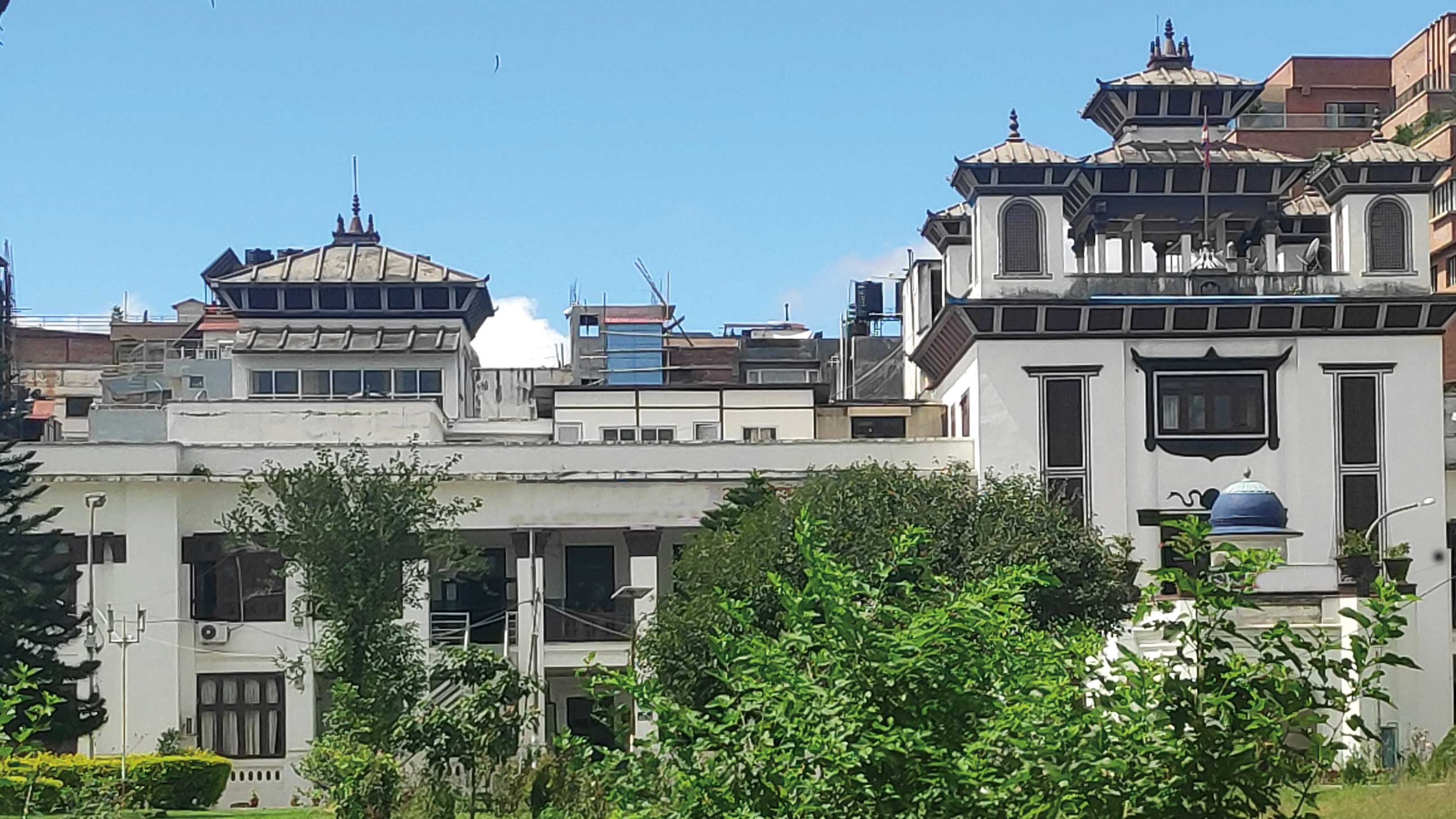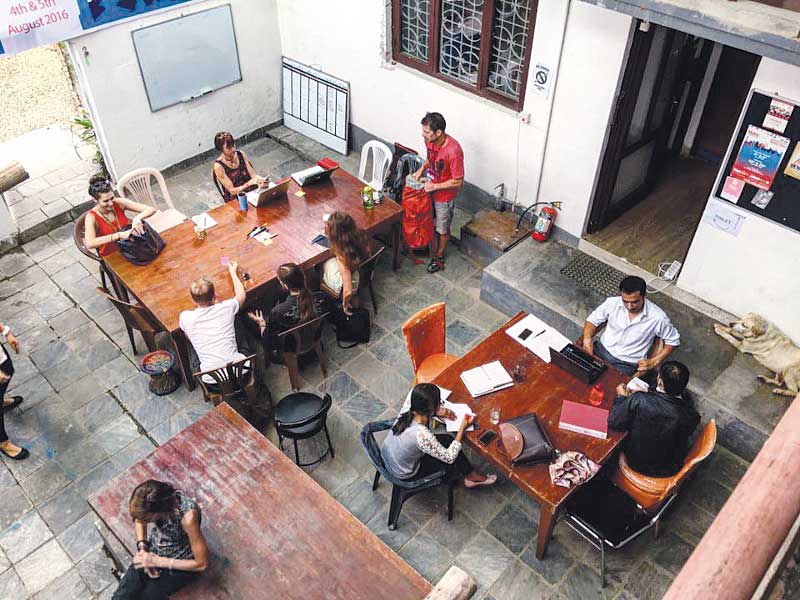
So still, so quiet... No crowds, dogs barking, busses revving or trucks honking. Was that an owl hooting softly off in the forest? In the early morning sit undisturbed on a verandah or at the picture window in your room and watch hillside farms and villages come awake, and listen to the birds, while sipping tea or coffee. A few nights’ stay at Dwarika’s Himalayan Shangri-La Village Resort at Dhulikhel is like that—peaceful, restful, calm. Mountain peaks gleaming. Flowers blooming. Birds singing (bring binoculars: the birding is excellent!). Serene sunrises and sunsets set the pace. It’s the sort of get-away one needs now and then, far from the hustle and frenzy of Kathmandu.
Dhulikhel, less than an hour’s drive east of Kathmandu, is an exceedingly tourist-friendly town, well-located for a pleasant stay. The drive reminds you why it is so good to get out of the congested, polluted valley to visit a clean-air forested resort in the rural countryside. Dwarika’s Himalayan Shangri-La Village Resort is, of course, not the only great place to stay in Dhulikhel. There are several fine resorts and hotels that rate high in terms of stunning location, first-class amenities and ‘classy’ service. The amenities at Dwarika’s include a modern bathroom in every unit, fans in summer and heaters for winter. During really cold weather, the beds are pre-warmed each evening for your comfort. Some of the other great hotels at Dhulikhel are the Himalayan Horizon (Sun-n-Snow) Hotel, Dhulikhel Lodge Resort, Dhulikhel Mountain Resort and High View Resort, to name a few. In fact, there are over 24 hotels in and around the town, some with high ‘star’ ratings. Altogether there are over 300 rooms available for guests in Dhulikhel, and some hotels have small to medium sized convention facilities. Several are situated in a forested location, among which Dwarika’s is the farthest from busy roads and noisy traffic
Dwarika’s story
Dwarika’s story begins back in 1952, well before the opening of Dwarika’s first hotel in Kathmandu. One morning while out jogging, the hotel’s founder Dwarika Das Shrestha noticed some carpenters sawing off a portion of an intricately carved wooden house pillar. The old structure was being removed to make way for a modern building. Bits and pieces of exquisitely carved woodwork, several centuries old, lay scattered about. These pieces, the workmen said, were about to be carried away for firewood. Dwarika realized that here was some of Nepal’s most exquisite and irreplaceable artistic heritage about to go up in smoke!
At first a hobby, then a passion and ultimately a lifetime quest, Dwarika began collecting cast-off posts, pillars and intricately carved Newar-style windows that were being removed in the wake of Kathmandu’s modernizing boom. As his collection grew, he began building the hotel in Kathmandu incorporating these ancient art forms into the building’s structure, its splendidly appointed rooms, and lush gardens. Dwarika’s wife Ambika and daughter Sangita shared his passion, and after Dwarika Das passed on (in 1992) they continued his dream. Today, Dwarika’s is Kathmandu’s most exceptional hotel for tourists and affluent Nepalese. In his own words, Dwarika’s is an architectural “asylum and hospital for the care of wounded masterpieces in wood” restored to their original beauty as a living museum. In 1980, in recognition for preserving Nepal’s ancient art of woodcarving, and its Newar architecture, Dwarika’s Hotel was recognized internationally by winning the Pacific Area Travel Association’s first PATA Heritage Award.
Dwarika’s new resort in the Dhulikhel hills is the hotel’s most recent venture. In 2006 the management took a significant step forward by acquiring the Shangri-La Village Resort as a natural extension of their style of fine service. For the first year, the resort staff were intent on upgrading the facilities by incorporating the special Dwarika touch. While still maintaining some aspects of the original architectural motif that identifies Dwarika’s urban hotel as unique and stunning, the countryside resort’s special identity is more focused on the ageless ambience of village Nepal and the natural environment. The resort staff are especially careful to preserve, maintain and expand its attractive atmosphere. The existing gardens cascading down the slope are nice, but future plans include featuring medicinal herbs, a spice garden, additional flowering shrubs and fruit trees. Solar panels have recently been installed for hot water. A pony trail (with Tibetan ponies) is planned, along with some enhancement of the viewpoint on the hilltop 10 minutes’ walk above. Resort tariffs include special resident expatriate, Nepali and corporate rates. (Check with the resort management for current prices.)
Like the famous Dwarika’s Hotel in Kathmandu, the resort at Dhulikhel has the same good food, spacious and well-appointed rooms and superb guest services, with attention to every detail. The restaurant features with both indoor and patio service and the lounge has a fireplace (nice in winter!). One thing missing—but for peace of mind is not necessary—is television in every room. Instead, there’s a large screen TV in one corner of the comfortable lounge. Recently, when an air conditioning technician came to discuss installation, he was heard to remark that “This place is not good for AC. It disturbs the environment.” In short, with both an eye and an ear to the natural ambience of the place, Dwarika’s Himalayan Shangri-La Village Resort has all that is needed for guest comfort. Dhulikhel in is a destination where you can leave your cares and stress behind, then sit back and absorb the natural ambience and the sweeping panorama of snow peaks topped by Shishapangma, Gaurishankar, Numbur Himal and others spreading eastward
towards Mt Everest.
Destination Dhulikhel
The old Newar trading town of Dhulikhel is located on a hilltop at 1700 meters (5600 feet). Visitors at any of its fine hotels and resorts have a variety of activities to choose from, if relaxing comfortably in a sunny garden is not enough. There’s a day walk to the Tibetan stupa and monastery of Namobuddha, then down through beautiful farm fields to the medieval village of Panauti. Another hike takes one across a countryside not often visited by tourists, through picturesque Panchkhal valley to Manegaon, a Tamang ethnic community. Shorter walks include a visit to the Bhagawati temple at Palanchowk, or to Baralgaon-Tinpipal to see typical village lifestyles, or a Dhulikhel- to-Panauti country walk. Longer excursions can also be arranged—by car to Kodari and the Tibetan border, or for rafting through the spectacular Sun Kosi river gorge.
A leisurely stroll through old Dhulikhel offers visitors a glimpse of the richness of ethnic Newar town life. Dhulikhel was first settled several centuries ago as a stop on the Kathmandu-to-Tibet overland trade route. After construction of the Arniko Highway, it began to modernize—but in ways that have not diminished the town’s ancient architectural, religious and cultural heritage. Residents now benefit from modern technology and quality education, social and health services. There are good roads and electricity, fine schools (including Kathmandu University), a large community hospital and sophisticated water and sanitation systems, all created with an ethic of cleanliness and environmentally friendly development. Dhulikhel is also known for its high number of voluntary organizations and youth groups, reflecting the social consciousness of its residents. Temples and other religious sites abound, and throughout the year a number of colorful social and religious festivals are celebrated. (Ask your travel agent or hotel/resort staff what’s on during your visit.)
Back at the resort during the afternoon you can have one of the Dwarika’s special massages. They come in four types: ‘Ancient’, ‘Ayurvedic’, ‘Deep Tissue Vibrational’ and ‘Traditional Newari’. The latter is done using a soothing blend of herbal oils, acupuncture points and spinal cord relaxing, to stimulate breath and circulation. Then, relax in the lounge with an aperitif before a Western or traditional Newari dinner. Nepali food is a specialty and Dwarika’s dal-bhat is exceptional, topped off with sikarni, a sweet spiced yogurt dessert. Rooms for the night come in two styles mimicking traditional Newari and hill Gurung house styles, with a fine Newari interior touch. Enjoy your sleep high above the pin-point lights of the surrounding villages and farmsteads..., and the
occasional call of an owl.
Contact Dwarika’s Himalayan Shangri-La Village Resort by phone at (011) 490612 or by email at info@dwarikashimalayanshangrila.com. The head office in Kathmandu is at Dwarika’s Hotel on Battisputali Marg. Phone 447.9488 or email info@dwarikas.com. At the website, www.dwarikas.com, click on the Village Resort link.
Gokarna Forest Resort The Royal Hunting Ground
As you drive along the winding roads that lead you to the gates to Gokarna Forest Resort, its hard to...










